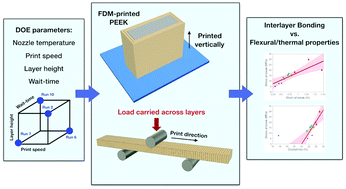Interlayer bonding strength of 3D printed PEEK specimens†
Abstract
Recent advances in extrusion-based filament 3D printing technology enable the processability of high-performance polymers. Poly(ether ether ketone) (PEEK) is an important group of high-performance polymer that has been widely used in aerospace, automotive, and biomedical applications. The interlayer bonding strength of 3D printed PEEK is crucial for load-bearing applications, yet studies on 3D printed PEEK are sparse due to processing challenges. In this study, the three-point flexural test is used to study the interlayer bonding strength of 3D-printed PEEK specimens with respect to the printing process parameters, including nozzle temperature, print speed, layer height, and wait-time. A design of experiment (DOE) approach is developed to study correlations between printing parameters and the end-use properties, including flexural stress (σf) and strain at break (εf), flexural modulus (Ef), and crystallinity (χ). Our results show that the nozzle temperature, layer height, and wait-time significantly affect the interlayer bonding strength, with nozzle temperature being the most influential parameter to enhance interlayer bonding strength indicated by a significant increase in σf, εf, and χ. Thermal annealing post-printing is shown to increase the degree of χ and Ef, yet its effect on interlayer bonding strength is minimal, indicating that the interlayer bonding strength is primarily determined during the printing process. This study demonstrates the use of a three-point flexural test integrated with a versatile and robust DOE approach to study the interlayer bonding strength of PEEK to reduce product development time while improving mechanical properties.



 Please wait while we load your content...
Please wait while we load your content...